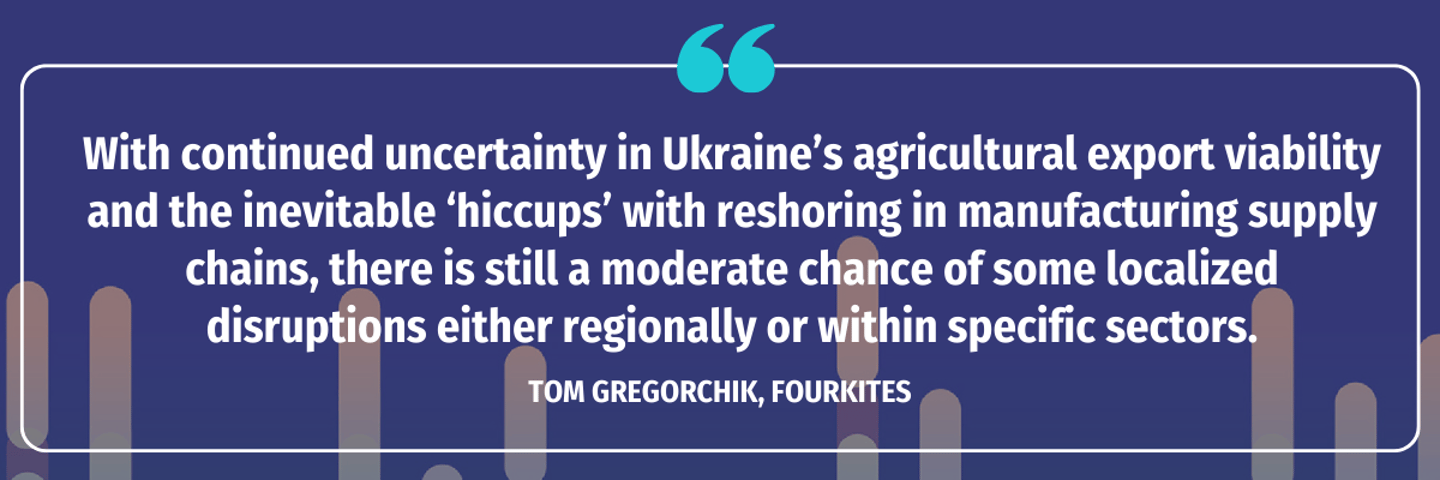Is the Supply Chain Crisis Over?
After several years of pandemic-related disruption and uncertainties, the global supply chain landscape appears to be on a tentative road to recovery in 2023. However, even though news has improved, this doesn't mean that all supply chain issues today have been laid to rest.
Despite the progress, CPG industry experts still caution against complacency. Here’s a look at some of the supply chain problems and solutions.
Are supply chain issues getting better 2023?
Things are looking up, according to Tom Gregorchik, VP of industry strategy at FourKites, who points to recovering inventory levels, diminished disruptions, and moderated consumer demand as all easing supply chain pressures.
That doesn’t mean that everything is smooth sailing, and there are still many supply chain issues today. “With continued uncertainty in Ukraine’s agricultural export viability and the inevitable ‘hiccups’ with reshoring in manufacturing supply chains, there is still a moderate chance of some localized disruptions either regionally or within specific sectors,” he notes. “That being said, the transportation side of the global supply chain has softened significantly.”
Douglas Kent, EVP of strategy and alliances at Association for Supply Chain Management (ASCM), expects that we won’t see a full “return to normal” for some time.
“There are still a variety of disruptions occurring,” he says “This year alone, we’ve seen increased cyberattacks, labor shutdowns and adverse climate events such as the wildfires in Quebec and Maui and the drought in the Panama Canal.”
What’s more, the increased U.S. focus on nearshoring and increasing domestic manufacturing translates to a deeper need for the talent to support these ambitions. Without it, he says, there’s the risk of more delays and heightened instability across the consumer goods industry.
What are the potential disruptions in supply chain?
There’s a few factors that could pose supply chain challenges, according to Gregorchik. Consumer demand for this year’s holiday peak season is still unclear, and many manufacturers have opted to reallocate capital expenditures to network development projects, such as reshoring, and reduced investments in new inventory purchases.
“While inventory levels have recovered following 2021-2022’s supply chain crisis, if consumer demand is higher than anticipated, there could be issues with fulfillment,” he warns.
“Additionally, while reshoring/nearshoring — the act of relocating manufacturing from APAC countries to North American regions — is designed to de-risk supply chains, this movement will add new stress to North American logistics networks. While Class-I railroads have worked hard to improve connectivity between MEX-USA-CAN, it still hasn’t experienced the surge in volumes that are bound to come with heightened manufacturing output in North America.”
What action can a company take to reduce the impact of a supply chain disruption?
Strategic planning, technology adoption, risk management, collaboration, and adaptability can all help companies alleviate ongoing supply chain issues, says Christian Roeloffs, co-founder and CEO of Container xChange. Indeed, all have a key role in shaping today’s supply chain technology trends.
“Companies should diversify their sources of supply, manufacturing, and distribution,” he advises. “Relying on a single source or location can be risky. Establishing redundant suppliers and alternative manufacturing sites can mitigate disruptions caused by unforeseen events.”
Supply chain technology can be a key enabler, particularly when managing fluctuating demand, and establishing flexible and resilient logistics networks can decrease delays caused by transportation disruptions, he notes.
Stronger relationships with suppliers is critical for long-term success, as collaboration, shared risk assessments, and clear communication can help manage supply chain disruptions effectively.
“Long-term partnerships enable companies to work together in overcoming challenges,” says Roeloffs.



